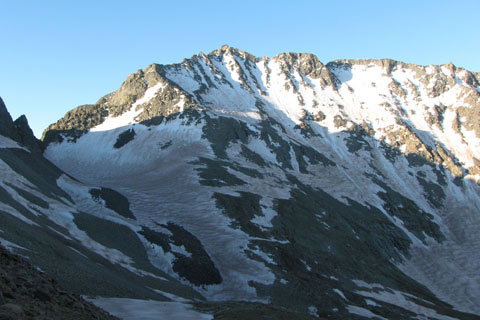| 632 | Trail Sense Lightning |
2012-04-30 |

High in the San Juan Mountains of southwest Colorado, Amy and I were climbing Mount Wilson (14,246') when the storm arrived. It was time for us to hunker down…
We had started from the Navajo Lake Trailhead early that morning with our friend, Nick. Our first goal was Wilson Peak which was fairly straightforward, except for the rotten rock on the mountain. Soon we descended the mountain, parted company with Nick, and were on our way to the slopes of Mount Wilson. We were moving fast for the conditions, but the lack of a trail slowed us down. Following the advice of a guidebook, we stayed below the ridge, but found many snow and ice chutes that we had to cross. We needed to wear crampons on the snow/ice, but found the spikes slowed us down moving over the rock. Using every trick in our repertoire, we desperately tried to move faster, but the building storm clouds caught us.
The first lightning strikes were close, then, the strikes came even closer. Hail pummeled us. Rain poured. We had to worry about finding a safe place to wait the storm out. Donning all our clothes and rain gear, we sat on our packs on an open slope a hundred feet or so below the ridge. We cuddled to try and stay warm.
The storm lasted forever as we were hit with wave after wave of high winds, lightning, and mostly frozen precipitation. Finally growing impatient I talked Amy into making a dash for the summit. The high point was much further away than expected. By the time we summited and returned to our packs, the storm finally moved past.
Amy and I agreed we were probably subject to more danger on Mount Wilson due to the storm, than on any of the other mountains (54 of them) that we climbed that summer.
Thunderstorms (with lightning) are a danger to hikers and climbers. The lightning strikes however are not limited to the Rockies and Sierras, they also occur in the eastern states. It is important for all hikers to be able to recognize the storms approach and take the necessary actions to lessen the chances of being struck.
A few lighting tips …
There are relatively few hikers hit by lightning. I think that is because the storms are scary, looking for a safe place is instinctive.
Lightning chooses the shortest path and therefore generally strikes the highest objects. That is why being on a summit is not generally a good place to be.
Other places to avoid are sheltering under the limbs of solo trees - when the lightning hits the tree the charge would go down the tree and could strike anyone close by.
Do not take shelter under a shallow overhang as the lightning could spark across the gap formed by the overhang.
If you are on a ridge or exposed high spot (summit), as the storm approaches, descend and seek shelter as quickly as possible.
Avoid water, metal objects, gullies, ravines, or ropes - all conduct the charge once it has hit the earth.
Hail is a good indicator to warn of lightning forming. Why lightning forms is still a bit of a mystery, but hail is almost in the clouds (whether it reaches the ground or not) before a lightning strike.
To judge the distance from the strike, on hearing thunder - the strike is one mile away for every five seconds.
To avoid exposure to the storms: climb early in the morning while in the mountains in order to avoid the afternoon storms (also appropriate at the east coast beaches), check the forecast, keep an eye to the sky, be ready to turn around, always prepare for storms.
Always carry rain gear. On Mount Wilson, we would have been very miserable if we did not have good rain gear in our packs.
If the storm catches you ...
Choose a location to hunker down - avoid water or being highest object. Deep within a forest is a much safer location
Get rid of all metal gear, you don’t want to be a lightning rod.
Put on your layers and rain gear.
Squat on your pack, rope, etc.
Position yourself by staying low, curled in a ball, allowing only your feet to touch the ground.
If in a group stay at least twenty feet apart. If one person is hit, the others may be able to perform CPR.
Wait on the storm to pass before continuing.
When you hear the buzz or your hair stands on end, you are probably not in a good location, move fast!
Happy lightning-less trails
Surviving the Storm - same story, but a bit different from 2010